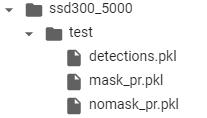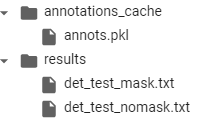制作类似pascal voc格式的目标检测数据集:https://www.cnblogs.com/xiximayou/p/12546061.html
训练自己创建的数据集:https://www.cnblogs.com/xiximayou/p/12546556.html
它的代码中的eval.py实际上使用的是test.txt里面的数据。
直接看修改后的代码:eval.py
"""Adapted from: @longcw faster_rcnn_pytorch: https://github.com/longcw/faster_rcnn_pytorch @rbgirshick py-faster-rcnn https://github.com/rbgirshick/py-faster-rcnn Licensed under The MIT License [see LICENSE for details] """ from __future__ import print_function import torch import torch.nn as nn import torch.backends.cudnn as cudnn from torch.autograd import Variable #from data import VOC_ROOT, VOCAnnotationTransform, VOCDetection, BaseTransform #from data import VOC_CLASSES as labelmap from data import MASK_ROOT, MASKAnnotationTransform, MASKDetection, BaseTransform from data import MASK_CLASSES as labelmap import torch.utils.data as data from ssd import build_ssd import sys import os import time import argparse import numpy as np import pickle import cv2 if sys.version_info[0] == 2: import xml.etree.cElementTree as ET else: import xml.etree.ElementTree as ET def str2bool(v): return v.lower() in ("yes", "true", "t", "1") parser = argparse.ArgumentParser( description='Single Shot MultiBox Detector Evaluation') parser.add_argument('--trained_model', default='weights/ssd300_mAP_77.43_v2.pth', type=str, help='Trained state_dict file path to open') parser.add_argument('--save_folder', default='eval/', type=str, help='File path to save results') parser.add_argument('--confidence_threshold', default=0.01, type=float, help='Detection confidence threshold') parser.add_argument('--top_k', default=5, type=int, help='Further restrict the number of predictions to parse') parser.add_argument('--cuda', default=True, type=str2bool, help='Use cuda to train model') #parser.add_argument('--voc_root', default=VOC_ROOT, # help='Location of VOC root directory') #parser.add_argument('--mask_root', default=MASK_ROOT, # help='Location of MASK root directory') parser.add_argument('--cleanup', default=True, type=str2bool, help='Cleanup and remove results files following eval') args = parser.parse_args() if not os.path.exists(args.save_folder): os.mkdir(args.save_folder) if torch.cuda.is_available(): if args.cuda: torch.set_default_tensor_type('torch.cuda.FloatTensor') if not args.cuda: print("WARNING: It looks like you have a CUDA device, but aren't using CUDA. Run with --cuda for optimal eval speed.") torch.set_default_tensor_type('torch.FloatTensor') else: torch.set_default_tensor_type('torch.FloatTensor') #annopath = os.path.join(args.voc_root, 'VOC2007', 'Annotations', '%s.xml') #imgpath = os.path.join(args.voc_root, 'VOC2007', 'JPEGImages', '%s.jpg') #imgsetpath = os.path.join(args.voc_root, 'VOC2007', 'ImageSets', # 'Main', '{:s}.txt') #YEAR = '2007' #devkit_path = args.voc_root + 'VOC' + YEAR mask_root="/content/drive/My Drive/pytorch_ssd/data/maskornot" annopath = os.path.join(mask_root, 'Annotations', '%s.xml') imgpath = os.path.join(mask_root, 'JPEGImages', '%s.jpg') imgsetpath = os.path.join(mask_root, 'ImageSets', 'Main', '{:s}.txt') devkit_path = mask_root #print(annopath,imgpath,imgsetpath) dataset_mean = (104, 117, 123) set_type = 'test' class Timer(object): """A simple timer.""" def __init__(self): self.total_time = 0. self.calls = 0 self.start_time = 0. self.diff = 0. self.average_time = 0. def tic(self): # using time.time instead of time.clock because time time.clock # does not normalize for multithreading self.start_time = time.time() def toc(self, average=True): self.diff = time.time() - self.start_time self.total_time += self.diff self.calls += 1 self.average_time = self.total_time / self.calls if average: return self.average_time else: return self.diff def parse_rec(filename): """ Parse a PASCAL VOC xml file """ tree = ET.parse(filename) objects = [] for obj in tree.findall('object'): obj_struct = {} obj_struct['name'] = obj.find('name').text obj_struct['pose'] = obj.find('pose').text obj_struct['truncated'] = int(obj.find('truncated').text) obj_struct['difficult'] = int(obj.find('difficult').text) bbox = obj.find('bndbox') obj_struct['bbox'] = [int(bbox.find('xmin').text) - 1, int(bbox.find('ymin').text) - 1, int(bbox.find('xmax').text) - 1, int(bbox.find('ymax').text) - 1] objects.append(obj_struct) return objects def get_output_dir(name, phase): """Return the directory where experimental artifacts are placed. If the directory does not exist, it is created. A canonical path is built using the name from an imdb and a network (if not None). """ filedir = os.path.join(name, phase) if not os.path.exists(filedir): os.makedirs(filedir) return filedir def get_voc_results_file_template(image_set, cls): # VOCdevkit/VOC2007/results/det_test_aeroplane.txt filename = 'det_' + image_set + '_%s.txt' % (cls) filedir = os.path.join(devkit_path, 'results') #print(filedir) if not os.path.exists(filedir): os.mkdir(filedir) path = os.path.join(filedir, filename) return path def write_voc_results_file(all_boxes, dataset): for cls_ind, cls in enumerate(labelmap): print('Writing {:s} MASK results file'.format(cls)) filename = get_voc_results_file_template(set_type, cls) with open(filename, 'wt') as f: for im_ind, index in enumerate(dataset.ids): dets = all_boxes[cls_ind+1][im_ind] if dets == []: continue # the VOCdevkit expects 1-based indices for k in range(dets.shape[0]): f.write('{:s} {:.3f} {:.1f} {:.1f} {:.1f} {:.1f} '. format(index[1], dets[k, -1], dets[k, 0] + 1, dets[k, 1] + 1, dets[k, 2] + 1, dets[k, 3] + 1)) def do_python_eval(output_dir='output', use_07=True): cachedir = os.path.join(devkit_path, 'annotations_cache') aps = [] # The PASCAL VOC metric changed in 2010 use_07_metric = use_07 print('VOC07 metric? ' + ('Yes' if use_07_metric else 'No')) if not os.path.isdir(output_dir): os.mkdir(output_dir) for i, cls in enumerate(labelmap): filename = get_voc_results_file_template(set_type, cls) rec, prec, ap = voc_eval( filename, annopath, imgsetpath.format(set_type), cls, cachedir, ovthresh=0.5, use_07_metric=use_07_metric) aps += [ap] print('AP for {} = {:.4f}'.format(cls, ap)) with open(os.path.join(output_dir, cls + '_pr.pkl'), 'wb') as f: pickle.dump({'rec': rec, 'prec': prec, 'ap': ap}, f) print('Mean AP = {:.4f}'.format(np.mean(aps))) print('~~~~~~~~') print('Results:') for ap in aps: print('{:.3f}'.format(ap)) print('{:.3f}'.format(np.mean(aps))) print('~~~~~~~~') print('') print('--------------------------------------------------------------') print('Results computed with the **unofficial** Python eval code.') print('Results should be very close to the official MATLAB eval code.') print('--------------------------------------------------------------') def voc_ap(rec, prec, use_07_metric=True): """ ap = voc_ap(rec, prec, [use_07_metric]) Compute VOC AP given precision and recall. If use_07_metric is true, uses the VOC 07 11 point method (default:True). """ if use_07_metric: # 11 point metric ap = 0. for t in np.arange(0., 1.1, 0.1): if np.sum(rec >= t) == 0: p = 0 else: p = np.max(prec[rec >= t]) ap = ap + p / 11. else: # correct AP calculation # first append sentinel values at the end mrec = np.concatenate(([0.], rec, [1.])) mpre = np.concatenate(([0.], prec, [0.])) # compute the precision envelope for i in range(mpre.size - 1, 0, -1): mpre[i - 1] = np.maximum(mpre[i - 1], mpre[i]) # to calculate area under PR curve, look for points # where X axis (recall) changes value i = np.where(mrec[1:] != mrec[:-1])[0] # and sum (Delta recall) * prec ap = np.sum((mrec[i + 1] - mrec[i]) * mpre[i + 1]) return ap def voc_eval(detpath, annopath, imagesetfile, classname, cachedir, ovthresh=0.5, use_07_metric=True): """rec, prec, ap = voc_eval(detpath, annopath, imagesetfile, classname, [ovthresh], [use_07_metric]) Top level function that does the PASCAL VOC evaluation. detpath: Path to detections detpath.format(classname) should produce the detection results file. annopath: Path to annotations annopath.format(imagename) should be the xml annotations file. imagesetfile: Text file containing the list of images, one image per line. classname: Category name (duh) cachedir: Directory for caching the annotations [ovthresh]: Overlap threshold (default = 0.5) [use_07_metric]: Whether to use VOC07's 11 point AP computation (default True) """ # assumes detections are in detpath.format(classname) # assumes annotations are in annopath.format(imagename) # assumes imagesetfile is a text file with each line an image name # cachedir caches the annotations in a pickle file # first load gt if not os.path.isdir(cachedir): os.mkdir(cachedir) cachefile = os.path.join(cachedir, 'annots.pkl') # read list of images with open(imagesetfile, 'r') as f: lines = f.readlines() imagenames = [x.strip() for x in lines] if not os.path.isfile(cachefile): # load annots recs = {} for i, imagename in enumerate(imagenames): recs[imagename] = parse_rec(annopath % (imagename)) if i % 100 == 0: print('Reading annotation for {:d}/{:d}'.format( i + 1, len(imagenames))) # save print('Saving cached annotations to {:s}'.format(cachefile)) with open(cachefile, 'wb') as f: pickle.dump(recs, f) else: # load with open(cachefile, 'rb') as f: recs = pickle.load(f) # extract gt objects for this class class_recs = {} npos = 0 for imagename in imagenames: R = [obj for obj in recs[imagename] if obj['name'] == classname] bbox = np.array([x['bbox'] for x in R]) difficult = np.array([x['difficult'] for x in R]).astype(np.bool) det = [False] * len(R) npos = npos + sum(~difficult) class_recs[imagename] = {'bbox': bbox, 'difficult': difficult, 'det': det} # read dets detfile = detpath.format(classname) with open(detfile, 'r') as f: lines = f.readlines() if any(lines) == 1: splitlines = [x.strip().split(' ') for x in lines] image_ids = [x[0] for x in splitlines] confidence = np.array([float(x[1]) for x in splitlines]) BB = np.array([[float(z) for z in x[2:]] for x in splitlines]) # sort by confidence sorted_ind = np.argsort(-confidence) sorted_scores = np.sort(-confidence) BB = BB[sorted_ind, :] image_ids = [image_ids[x] for x in sorted_ind] # go down dets and mark TPs and FPs nd = len(image_ids) tp = np.zeros(nd) fp = np.zeros(nd) #print(class_recs) for d in range(nd): #print(image_ids[d]) R = class_recs[image_ids[d]] bb = BB[d, :].astype(float) ovmax = -np.inf BBGT = R['bbox'].astype(float) if BBGT.size > 0: # compute overlaps # intersection ixmin = np.maximum(BBGT[:, 0], bb[0]) iymin = np.maximum(BBGT[:, 1], bb[1]) ixmax = np.minimum(BBGT[:, 2], bb[2]) iymax = np.minimum(BBGT[:, 3], bb[3]) iw = np.maximum(ixmax - ixmin, 0.) ih = np.maximum(iymax - iymin, 0.) inters = iw * ih uni = ((bb[2] - bb[0]) * (bb[3] - bb[1]) + (BBGT[:, 2] - BBGT[:, 0]) * (BBGT[:, 3] - BBGT[:, 1]) - inters) overlaps = inters / uni ovmax = np.max(overlaps) jmax = np.argmax(overlaps) if ovmax > ovthresh: if not R['difficult'][jmax]: if not R['det'][jmax]: tp[d] = 1. R['det'][jmax] = 1 else: fp[d] = 1. else: fp[d] = 1. # compute precision recall fp = np.cumsum(fp) tp = np.cumsum(tp) rec = tp / float(npos) # avoid divide by zero in case the first detection matches a difficult # ground truth prec = tp / np.maximum(tp + fp, np.finfo(np.float64).eps) ap = voc_ap(rec, prec, use_07_metric) else: rec = -1. prec = -1. ap = -1. return rec, prec, ap def test_net(save_folder, net, cuda, dataset, transform, top_k, im_size=300, thresh=0.05): num_images = len(dataset) # all detections are collected into: # all_boxes[cls][image] = N x 5 array of detections in # (x1, y1, x2, y2, score) all_boxes = [[[] for _ in range(num_images)] for _ in range(len(labelmap)+1)] # timers _t = {'im_detect': Timer(), 'misc': Timer()} output_dir = get_output_dir('ssd300_5000', set_type) det_file = os.path.join(output_dir, 'detections.pkl') for i in range(num_images): im, gt, h, w = dataset.pull_item(i) x = Variable(im.unsqueeze(0)) if args.cuda: x = x.cuda() _t['im_detect'].tic() detections = net(x).data detect_time = _t['im_detect'].toc(average=False) # skip j = 0, because it's the background class for j in range(1, detections.size(1)): dets = detections[0, j, :] mask = dets[:, 0].gt(0.).expand(5, dets.size(0)).t() dets = torch.masked_select(dets, mask).view(-1, 5) if dets.size(0) == 0: continue boxes = dets[:, 1:] boxes[:, 0] *= w boxes[:, 2] *= w boxes[:, 1] *= h boxes[:, 3] *= h scores = dets[:, 0].cpu().numpy() cls_dets = np.hstack((boxes.cpu().numpy(), scores[:, np.newaxis])).astype(np.float32, copy=False) all_boxes[j][i] = cls_dets print('im_detect: {:d}/{:d} {:.3f}s'.format(i + 1, num_images, detect_time)) with open(det_file, 'wb') as f: pickle.dump(all_boxes, f, pickle.HIGHEST_PROTOCOL) print('Evaluating detections') evaluate_detections(all_boxes, output_dir, dataset) def evaluate_detections(box_list, output_dir, dataset): write_voc_results_file(box_list, dataset) do_python_eval(output_dir) if __name__ == '__main__': # load net num_classes = len(labelmap) + 1 #print(num_classes) # +1 for background net = build_ssd('test', 300, num_classes) # initialize SSD net.load_state_dict(torch.load(args.trained_model)) net.eval() print('Finished loading model!') # load data dataset = MASKDetection(mask_root, set_type, BaseTransform(300, dataset_mean), MASKAnnotationTransform()) if args.cuda: net = net.cuda() cudnn.benchmark = True # evaluation test_net(args.save_folder, net, args.cuda, dataset, BaseTransform(net.size, dataset_mean), args.top_k, 300, thresh=args.confidence_threshold)
开始执行:
!python eval.py --trained_model weights/ssd300_MASK_5000.pth --top_k 1
运行结果:
Finished loading model! /pytorch/torch/csrc/autograd/python_function.cpp:622: UserWarning: Legacy autograd function with non-static forward method is deprecated and will be removed in 1.3. Please use new-style autograd function with static forward method. (Example: https://pytorch.org/docs/stable/autograd.html#torch.autograd.Function) im_detect: 1/80 2.040s 。。。。。。 /pytorch/torch/csrc/autograd/python_function.cpp:622: UserWarning: Legacy autograd function with non-static forward method is deprecated and will be removed in 1.3. Please use new-style autograd function with static forward method. (Example: https://pytorch.org/docs/stable/autograd.html#torch.autograd.Function) im_detect: 80/80 0.068s Evaluating detections Writing mask MASK results file Writing nomask MASK results file VOC07 metric? Yes AP for mask = 0.8982 AP for nomask = 0.0629 Mean AP = 0.4806 ~~~~~~~~ Results: 0.898 0.063 0.481 ~~~~~~~~ -------------------------------------------------------------- Results computed with the **unofficial** Python eval code. Results should be very close to the official MATLAB eval code. --------------------------------------------------------------
由于我标注的数据集中很少有nomask(即不戴口罩的),因此nomask的AP较低也很正常。最后看看都生成了哪些文件:

